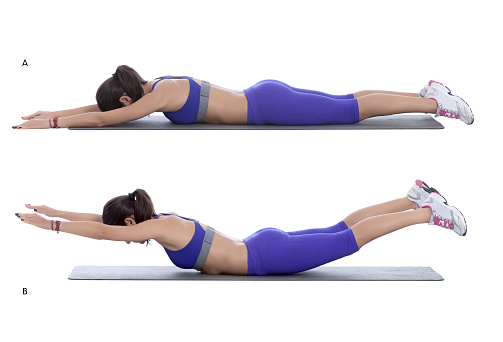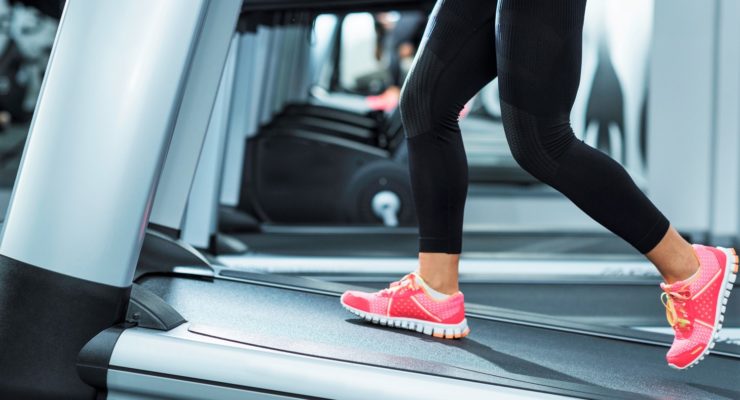5 Crunch-Free Moves for Flatter Abs
Article posted in: Fitness
Let’s dispel with the notion that crunches “don’t work”: They’re actually very effective at contracting the rectus abdominis, or “six-pack” muscle.
But there’s much more to a flat belly and “having abs” than a strong rectus abdominus, and your core consists of a bunch of muscles besides the rectus—muscles that are ignored by crunches. Your core also serves lots of muscular functions besides bringing your chest closer to your thighs, including rotation and spinal stability—and that spinal stability can help alleviate and ward off back pain.
Which brings up the other problem with crunches: With every rep, you’re rounding your lower back, potentially causing pain and even injury. You can get the same rectus abdominus activation while improving the other muscles of your abdomen by mixing in a host of other exercises. Try these five moves for a stronger stomach:
1. Upgrade your plank to work your whole core:
Planks are no secret as an ab exercise, and that’s because they’re effective: In a 2001 study conducted by the American Council on Exercise, the plank matched the crunch for rectus abdominis activity. But if you’re doing them lazily, they’re not as effective. Try these three tips for more effective planks:
First, create a straight body line. Whether you’re on your forearms or your hands, the first key to a great plank is to create a straight body line from your head to heels. Avoid sagging your hips or popping them up, and keep your head in line with your shoulders. This straight body line is the plank you’re looking to emulate—a straight, strong board. Maintain that line throughout the exercise.
Next, flex everything. Instead of just balancing on your hands and forearms, take control of the plank: Brace your core like you’re about to be punched, and flex your glutes, thighs, and calves. If you’re doing a straight-arm plank, engage your hands by actively gripping the floor. Engaging your body turns the plank from a passive exercise into an active one that trains your whole body.
Finally, progress your plank. If you can hold an active, straight forearm plank for a minute, try doing the exercise on your hands in a full pushup position. Once that’s too easy, try shoulder taps: Start in the straight-arm plank position, with a straight body line from head to heels. Without changing the angle of your hips or shoulders, lift your right hand off the ground and bring it up to touch your left shoulder. Return to the ground, re-stabilize, and bring your left hand up to your right shoulder. Repeat 10 times, or until you lose the integrity of your plank.
2. Literally shrink your waist with the vacuum exercise:
You can’t change the width of your hips, but you can shrink your waist front to back, and this exercise can train you to do make that space as small as possible. It works a muscle called the transverse abdominis, a belt-shaped muscle in your core that helps secure your organs near your spine and creates spinal stability. And that stability gives this exercise a bonus: As you strengthen your TVA, you can reduce lumbar back pain.
Start with a supine version of the exercise a few times each week: To do it, lie face up on your back with your knees bent and feet flat on the floor. Forcefully exhale all the air in your lungs. As you breathe in, try to bring your belly button as close to your spine as you can—the closer you get it to your spine, the harder your TVA is working. Continue holding your belly button in as you breathe in and out. With each exhale, try to bring your navel closer and closer to your spine. Continue this for 15 to 20 seconds. Rest for about 30 seconds, then repeat two more times.
3. Twist like an athlete with the tight core rotation:
Besides looking flat or flabby, the muscles of your core have functions—they hold your spine in a stable position, as in the vacuum, and they’re also used for healthy, safe rotation of the torso. Many core exercises that feature rotation, like a wood chopper, feature long, slow rotations. But trainer Nick Tumminello, author of “Strength Training for Fat Loss” and other books, created and helped popularize a smaller rotational exercise. This “tight core rotation” mimics the way a sprinter rotates their core while swinging their arms—in shorter, choppier movements. So your core functions more the way an athlete’s does; and if you do the exercise, you’ll feel it!
To do this exercise, stand with your knees slightly bent, and your arms extended in front of your stomach, palms together. Keeping your legs and hips steady and your hands pointing directly in front of your sternum, rotate your shoulders to the right to move your hands so that they would now point to 1 o’clock. Then rotate your shoulders back across 12 until your hands point to 11 o’clock. Using that range, begin quickly and forcefully swinging your shoulders (and with them, your hands) from 11 o’clock to 1 o’clock and back again. Continue for 8 to 10 seconds. Rest for 15 seconds, and repeat for 2 more sets.
4. Reverse your crunch with a Superman:
Crunches have become vilified in many circles because they put your lower back into a rounded position that can cause pain after the exercise. You can strengthen the muscles of your low back and give your glutes a boost while performing a lengthening stretch on your rectus abdominis with an exercise that reverses the movement of a crunch: It’s called a Superman.
To do it, lie face down on a mat or padded floor (like a carpet) with your legs straight and your arms extended overhead. Slowly and simultaneously raise your arms, chest, and legs a few inches off the floor. At the top of this position, you’ll look like you’re flying like Superman. Hold this position for 2 seconds, then slowly return to the floor. Repeat 4 or 5 times. As the exercise becomes easier, try extending how long you hold the flying position. Eventually, while holding the flying position, try rolling slightly to your left and right while keeping a straight body line, as if you were Superman weaving around buildings.

5. Work your lower abs by pretending you’re a dead bug:
Some of the best exercises have the silliest names, but the dead bug might be the silliest. Fortunately, it’s so effective you’ll forget to notice. The legs-only version of the variation below is a great, low-intensity way to target your lower abdominals, and both versions are a great opportunity to practice contracting and controlling your transverse abdominis.
Start with the legs-only dead bug: Lie face up with your knees bent. Hold your arms straight in front of your shoulders so they’re perpendicular to the floor (think of a zombie pose). Now bring your legs up into a tabletop position, with your thighs perpendicular to the floor, your lower legs parallel with the floor, and your knees bent at 90-degree angles. Draw your navel towards your spine as you did in the vacuum exercise, pressing your low back into the floor. Without changing the bend in your knee, lower your right foot to the floor, tap the floor, and return it to the tabletop. Repeat with your left leg. That’s one repetition. Perform 8 reps per set, and go for 3 sets.
For the arms-only dead bug, start in the same position, with legs in tabletop, arms in zombie position, and your lower back pressed into the floor. Keeping everything else still, lower your right arm back above your head, touching the floor behind you. Return it to the zombie position, and repeat with your left arm. That’s one repetition. Do 3 sets of 8 reps.














